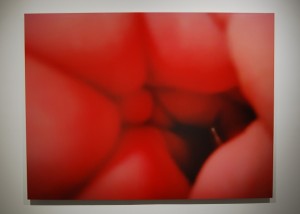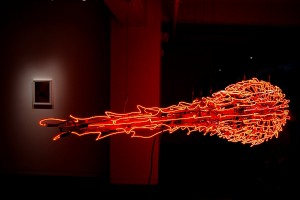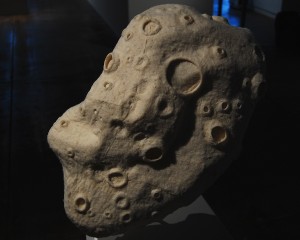It is always refreshing to find an artist with a body of work that is as solid as it is diverse. At Fleisher/Ollman’s May exhibition Voyeur, Tristin Lowe proves that he is just such an artist – working in mediums as divergent as cell phone photography, felt sculptures, and glowing neon lights. Lowe’s explorations range from abstractions on a personal level to images of cosmic proportion, and he does so with an unabashed, yet accessible amount of curiosity and humanism.

Near the entryway, and throughout the show, hang a multitude of large – between two and four foot – photographic prints. They are heavily abstracted, and glow with strong highlights and shades of red and pink. It takes quite a bit of analysis (and maybe even an explanation from the artist) to determine that the subjects are close-up images of hands in various contortions. The images are very inviting and comforting to look at and their soft qualities are due in part to the fact that they were captured by a simple cell phone camera. They exude human warmth even without the knowledge of their source and contain undertones of the womb, of sexual embrace (appropriately part of the “Handjob” series), and of vitality in general.

Complemented by the hues of the photos, and illuminating the entire show, is the radiant centerpiece: a huge, three-dimensional comet constructed from twisting, red neon tubes. It is 10 feet long, and the focal point of the show in both placement and magnitude. When asked why he chose a comet, Lowe began a lengthy barrage of images and anecdotes, making it clear that his seemingly disconnected works and thought processes were actually quite scientific, while at the same time rather associative. From the very Carl Sagan-like assertion that we are made from star dust, to the visual similarities between comets and sperm cells, the life of the photos, the energy of the neon tubes, and the cosmic themes all begin to fall into place.

Lowe’s felt pieces serve as the midpoint, at times both soft and celestial. While not all of the objects fit as neatly into these categories, for instance a door or a pair of jeans, most have obvious parallels: a relief sculpture of the moon hanging high on the wall, a meteorite pockmarked with craters, and a pair of binoculars. The novelty of seeing these items made from fabric (with the exception of the jeans) highlights Lowe’s quirky humor. Where the visual play doesn’t quite fit, he tailors his wordplay to make the themes snug. The pants, entitled: Genes: Standard Model, introduces the biological tie-in which brings the show thematically full circle.
An artist this engaging for so many reasons is a rare find. Tristin Lowe’s show is smart, funny, and varied; it asks big questions about who we are and where we come from in a multitude of pertinent ways, but it does so with a wry charm. Microcosmic as well as stellar, this show is pretty nearby for being so out of this world.









